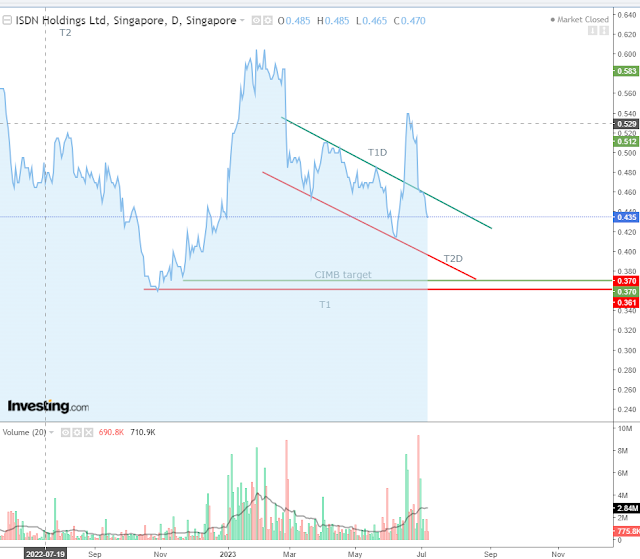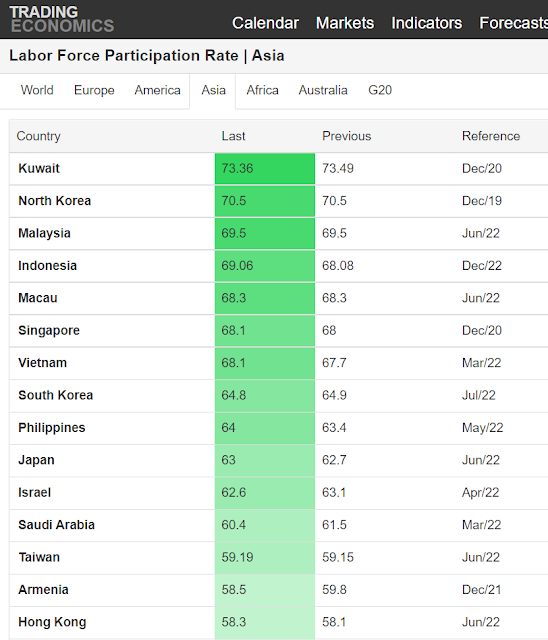16 July 2023
In the last post on 8 July 2023, we said that the SIA price was
forming another Flag. This Flag2 has
now been completed as shown in the following chart.
If the SIA price can pierce through the top of the flag pole (colored green), we might see the SIA price makes attempts to cover the candlestick gap created on 30 July.
About the Candlestick Gap
When Temasek Holdings sold away 400 million shares on 30
July, it created a candlestick gap with
a price drop of S$0.35 or 5% as shown in the following chart
This gap is not only large but also has a trading volume of 85 million shares. This share volume was about 13 times the average 100-day trading volume. It is definitely a “runaway” candlestick gap.
According to the textbooks, a “runaway” candlestick would usually take months or years to fill. Those interested to know more about runaway candlestick can find more detail here
Why are They Selling?
SIA has been performing rather well after the end of the pandemic.
In 2022, It has posted the highest net profit in its entire 76 years of operation. Some
traders have expected the 1Q2023 earnings to be even higher. Then why are the big players selling?
Earlier on, we posted
that the broker houses and the analysts expected
a) A tapering in the number of air passengers, leading to a decline in earnings.
b) The SIA to spend
1) Billions to redeem the mandatory convertible bonds (MCB) they raised in March/April 2020.
2) A lot to renew its aircraft fleet, plus
c) The SIA to allocate funds for the merger of the Vistara/Air India group.
One other reason that has not been speculated so far is whether the SIA price has been running up too quickly too fast in 2023.
Is SIA Price Running Too Quickly Too Fast?
Presently, the
World’s 5 best airlines in 2023 are
1. Singapore Airline
2. Qatar Airways
3. ANA All Nippon Airways
4. Emirates
5. Japan Airlines
Except for Qatar Airways which is 100% Qatar Government owned, the rest of the airlines are listed companies where we can compare their stock prices.
It can be seen
from the following chart and the table that SIA price has indeed been running way ahead among the
airlines for the last 6 months in 2023. Its price has more than doubled the prices of other airlines
Going forward, we would expect very strong resistance for the SIA price to break the top of Flag2. It would be even harder for SIA shares to cover the candlestick gap unless the big players can reverse their earlier decision and decide to enter the market again. Breaking up the resistances can only happen soon if the SIA's 1Q 2023 results to be announced on 27 July are so unbelievably good, prompting players like Temasek Holding to regret and to buy back the SIA shares.
8 July 2022
In the past week after Temasek Holding sold 400 million SIA shares and after 3 or 4 broker houses and analysts downgraded SIA had set a target price of S$6.80, the SIA prices have been going strong as shown in this stock chart.
We can clearly see that the market wasn’t ready to send SIA
down immediately. The SIA prices have defied and made
an attempt, trying to recover from when the prices closed up from a one-month low of S$7.15 on
30 June to S$ 7.32. The price gained about 2.3% for the week.
Isn't the Price going down to S$6.80?
No one can tell at the moment as this has not happened yet. There is nothing concrete about the target price set by the broker houses/Analysts. The price could change due to traders' sentiment and prevailing news. Temasek Holdings can also make the price jump again for example.
This technical chart is showing exactly the situation.
The SIA price is presently raising its head above the trendline T1. It is ready to head higher as long as it can stay above this trendline T1. However, we are spotting another bearish flag being formed. It is marked as flag 2. This flag would take the SIA price higher to about S$ 7.40 before touching the flag top and before deciding if it is going to go down again.
Can the Bearish Flag Pattern Fail?
There is nothing concrete about the result of any kind of analysis. This is especially for stock Technical Analysis. They can only be used for reference.
Technical Analysis is only telling us that there is a possibility or there is a potential. They cannot tell us about the minds of the traders and what they are going to do next.
There are many examples one can find on the Net about how Technical Analysis had failed; for example, a bearish flag can turn out to be a bullish flag in the end.
Here is one textbook example This webpage is giving us some advice on how to spot a bearish or bullish flag and how to trade when that happened.
How to Spot a Failed Flag Pattern?
The textbook has this to say:
A properly formed flag would have the following features:
1. 1. Trading volume should increase just before the flag is formed;
2. 2. Trading volume should then decrease while the flag is being formed;
3. 3. The price
should touch the top of the pole for a
bearish flag or vice versa to complete the flag; finally and most importantly;
4. 4. The
volume must increase again when the price breaks the lower flag pole for a
bearish flag or the upper flag pole for a bullish flag.
The SIA price pattern fits exactly these descriptions for a
bearish flag to be formed.
Going forward, traders are advised to be on alert and watch how the price form the bearish flag.
8 July 2023
Singapore Tourist Arrivals 2023
The tourist arrivals to Singapore were around 1.1 million for June 2023 as shown in the attached picture. This figure has been maintained over the last 3 months and doubled over the year as compared to 543,000 in June 2022. The Singapore Tourism Board (STB) has predicted that Tourist Arrivals to Singapore would be in the range of 12 to 14 million in 2023. To date, tourist arrivals to Singapore have risen to 12.59 million, which is an increase of about 586% YOY.
30 June 2023
Temasek Holdings Selling $400 million worth of SIA shares
This news about Temasek Holdings selling SIA shares has caused Singapore Airlines (SIA) share price to tumble and lost 4.76% or S$0.35 per share today. It has also formed a glaring candlestick gap as shown in the following chart.
Temasek Holdings explained that it is always their routine "to reshape and rebalance their portfolio so that they can deliver sustainable returns over a longer term." Temasek Holdings also said it would continue to be a significant shareholder in SIA with a 53.5 percent stake.
Example of what would happen?
What is the Takeaway?
Whether the SIA would have a bad 2Q or the 3Q report in 2023 like SM in 2012 would be anybody's guess. But it would be advisable for investors to be cautious and do the necessary due diligence before buying or loading more SIA shares.




















.gif)
















